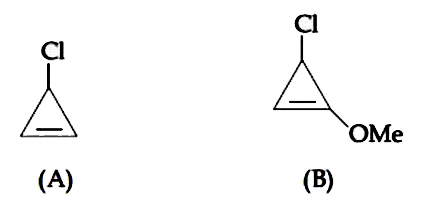Arrange the following molecules from most to least polar.
CH4ICF2Cl2IICF2H2IIICCl4IVCH2Cl2V
III gt V gt II gt I = IV
II gt IV gt III gt IV gt I
III gt II gt V gt IV gt I
V gt III gt II gt IV gt I
The correct Answer is:A
To determine the polarity of the given molecules (CH₄, CF₂Cl₂, CF₂H₂, CCl₄, and CH₂Cl₂), we will analyze their structures and the electronegativities of the atoms involved. The polarity of a molecule is influenced by the presence of polar bonds and the molecular geometry.
1. Identify the Electronegativity of Atoms:
- Carbon (C) has an electronegativity of about 2.5.
- Fluorine (F) has an electronegativity of about 4.0.
- Chlorine (Cl) has an electronegativity of about 3.0.
- Hydrogen (H) has an electronegativity of about 2.1.
2. Analyze Each Molecule:
- CH₄ (Methane):
- Tetrahedral geometry with C-H bonds.
- The dipole moments cancel out due to symmetry.
- Polarity: Nonpolar (Dipole moment = 0).
- CCl₄ (Carbon Tetrachloride):
- Tetrahedral geometry with C-Cl bonds.
- The dipole moments cancel out due to symmetry.
- Polarity: Nonpolar (Dipole moment = 0).
- CF₂Cl₂ (Dichlorodifluoromethane):
- Tetrahedral geometry with two F and two Cl atoms.
- F is more electronegative than Cl, leading to a net dipole moment.
- Polarity: Polar (Dipole moment > 0).
- CF₂H₂ (Difluoromethane):
- Tetrahedral geometry with two F and two H atoms.
- The electronegativity difference between F and H creates a significant dipole moment.
- Polarity: Polar (Dipole moment > CF₂Cl₂).
- CH₂Cl₂ (Dichloromethane):
- Tetrahedral geometry with two Cl and two H atoms.
- The electronegativity difference between Cl and H creates a dipole moment.
- Polarity: Polar (Dipole moment < CF₂H₂ but > CF₂Cl₂).
3. Rank the Molecules by Polarity:
- Most Polar: CF₂H₂
- Second: CH₂Cl₂
- Third: CF₂Cl₂
- Least Polar: CH₄ and CCl₄ (both nonpolar)
4. Final Arrangement from Most to Least Polar:
- CF₂H₂ > CH₂Cl₂ > CF₂Cl₂ > CH₄ = CCl₄
Final Answer:
The order of polarity from most to least polar is:
CF₂H₂ (III) > CH₂Cl₂ (V) > CF₂Cl₂ (II) > CH₄ (I) = CCl₄ (IV)
- Carbon (C) has an electronegativity of about 2.5.
- Fluorine (F) has an electronegativity of about 4.0.
- Chlorine (Cl) has an electronegativity of about 3.0.
- Hydrogen (H) has an electronegativity of about 2.1.
- CH₄ (Methane):
- Tetrahedral geometry with C-H bonds.
- The dipole moments cancel out due to symmetry.
- Polarity: Nonpolar (Dipole moment = 0).
- CCl₄ (Carbon Tetrachloride):
- Tetrahedral geometry with C-Cl bonds.
- The dipole moments cancel out due to symmetry.
- Polarity: Nonpolar (Dipole moment = 0).
- CF₂Cl₂ (Dichlorodifluoromethane):
- Tetrahedral geometry with two F and two Cl atoms.
- F is more electronegative than Cl, leading to a net dipole moment.
- Polarity: Polar (Dipole moment > 0).
- CF₂H₂ (Difluoromethane):
- Tetrahedral geometry with two F and two H atoms.
- The electronegativity difference between F and H creates a significant dipole moment.
- Polarity: Polar (Dipole moment > CF₂Cl₂).
- CH₂Cl₂ (Dichloromethane):
- Tetrahedral geometry with two Cl and two H atoms.
- The electronegativity difference between Cl and H creates a dipole moment.
- Polarity: Polar (Dipole moment < CF₂H₂ but > CF₂Cl₂).
- Most Polar: CF₂H₂
- Second: CH₂Cl₂
- Third: CF₂Cl₂
- Least Polar: CH₄ and CCl₄ (both nonpolar)
- CF₂H₂ > CH₂Cl₂ > CF₂Cl₂ > CH₄ = CCl₄
The order of polarity from most to least polar is:
CF₂H₂ (III) > CH₂Cl₂ (V) > CF₂Cl₂ (II) > CH₄ (I) = CCl₄ (IV)
Similar Questions
Knowledge Check
Arrange the following in decreasing order of basicity.
Cl−I RCOO−II OH−III RO−IV NH−2VAI>II<III>IV<VBV>IV>II>III>ICI>II>III>IV>VDV>IV>III>II>ICorrect name for the given compound
CH3−CH2−C∣CH2CH3H−CH2−C∣CH3H−CH2−CH3 isA3-ethyl-5-methylheptaneB5-ethyl-3-methylheptaneC1,1-diethyl-3-methylpentaneD3-methyl-5,5-diethylpentane
The order of stability of the alkenes
R2C=CR2'IR2C=CHRII,R2C=CH2'III<IVbr>(RCH=CHR,)andRCH=CH2V
is -
View SolutionThe order of stability of the alkenes
R2C=CR2'IR2C=CHEIIR2C=CH2'IIIRCH=CHR,IVandRCH=CH2V
is -
View SolutionGive the IUPAC name of the following compounds whose structures are given below :
CH3−C∣CH3H−CH2−CH2−C∣CH3H−C∣CH3H−CH2−CH3
View SolutionThe decreasing order of reactivity of the following organic molecules towards AgNO3 solution is

CH3CHCH3∣Cl(C) CH3CHCH2NO2∣Cl(D)
View SolutionArrange the following in the increasing order of their boiling points :
C2H5OH,CH2∣OH−CH2∣OH,CH2∣OH−CH2∣OH−CH2∣OH
View SolutionThe bond dissociation energies of the following
CH3−HI CH3CH2−HII CH2=CH−CH2−HIII C6H5−HIV
vary in the order :
View Solution